
The 1960s in America stands arguably as the defining decade of the 20th century, a period of immense social, technical, and cultural changes unparalleled in such a short span. From landing on the moon to widespread demands for social justice and an end to the Vietnam War, the nation was transformed. Amidst this whirlwind of events, the American car industry experienced a truly golden age, with Detroit emerging as the undisputed car capital of the world, delivering fantastic vehicles across all segments. This era saw everything from innovative compacts and dependable family sedans to sublime muscle and sports cars, each contributing to an indelible mark on automotive history.
This was indeed the heyday of limited-production models, NASCAR homologation specials, and relentless innovation, an era fondly remembered as the era of horsepower wars. Out of this crucible were born cars that still command reverence in modern times, from barn find treasures to stars of collector car auctions fetching sky-high bids. The magnetism of 1960s American iron is undeniable, with General Motors, Ford, and Chrysler locked in fierce competition, pushing the boundaries of design and engineering. The decade fostered a spirit of defiance, infused with style and performance, that resonated deeply with the American imagination.
In this deep dive, we journey through the first half of a curated list of the most legendary and memorable American cars from the ’60s, specifically those originally introduced between 1960 and 1969 that made an everlasting impression on the market. These are the machines that embody the spirit and innovation of their time, timeless icons cherished by collectors and admirers, and they vividly underscore why the 1960s have such a tight grip on our automotive psyche. Prepare to explore the pioneering power and distinctive designs that set the stage for America’s greatest car decade.

1. **1963 Chevrolet Corvette Z06**When the second-generation Corvette Sting Ray burst onto the scene in 1963, it was already a design masterpiece, instantly recognizable with its iconic split rear window and sleek, aerodynamic contours. Yet, Chevrolet had ambitions to push the Corvette’s potential even further, conceiving a special, race-ready package known internally by the codename RPO Z06. This option pack was far from a widely advertised offering; instead, it was a stealth weapon, primarily designed for the discerning SCCA racing customers who possessed the insider knowledge to navigate the factory order sheets, a testament to its specialized intent.
At its heart, the Z06 packed a formidable 327 cubic inch small-block V8 engine, enhanced with fuel injection to unleash an impressive 360–375 horsepower – a truly staggering figure for its time. Mated to this powerful engine was a close-ratio 4-speed manual transmission, specifically chosen to provide drivers with tight gear spacing, perfectly suited for the demands of rigorous track duty. This combination ensured that every shift contributed to a relentless surge of power and precise control, making it a formidable contender on any race circuit.
Beyond the powertrain, the Z06 received comprehensive chassis upgrades to handle its immense power and racing aspirations. It featured heavy-duty brake linings for superior stopping power, large-diameter shocks, and stiff springs to ensure exceptional handling and stability under extreme conditions. Crucially, it also boasted a massive 36.5-gallon fuel tank, a strategic addition designed to significantly reduce the need for pit stops during endurance events, giving racers a critical advantage. This meticulously engineered setup allowed the Z06 to sprint from 0–60 mph in a blistering around 5.8 seconds and reach a top speed near 140 mph, establishing it as a truly formidable competitor on both challenging road courses and open roads.
The 1963 Chevrolet Corvette Z06 owes its legendary status and immense reverence to its extreme rarity and potent racing pedigree. With fewer than 200 units ever produced, its exclusivity is undeniable, making it one of the most sought-after Corvettes in existence. Its advanced technology for the era, combined with its proven track record, secured its special place in the annals of automotive history. Today, discovering an original 1963 Z06 is akin to unearthing automotive gold, with examples regularly fetching prices in the high six or even seven figures at prestigious auctions, a clear indicator of its enduring desirability and iconic stature among collectors.
Car Model Information: 2020 Audi Q5 45 Premium
Name: Chevrolet Corvette
Caption: 2021 Chevrolet Corvette C8
Manufacturer: Chevrolet
Production: 1953–present
ModelYears: bulleted list
Assembly: bulleted list
Class: Sports car
BodyStyle: coupé
Layout: Front-engine, rear-wheel-drive layout,Rear mid-engine, rear-wheel-drive layout
Categories: 1950s cars, 1960s cars, 1970s cars, 1980s cars, 1990s cars
Summary: The Chevrolet Corvette is a line of American two-door, two-seater sports cars manufactured and marketed by General Motors under the Chevrolet marque since 1953. Throughout eight generations, indicated sequentially as C1 to C8, the Corvette is noted for its performance, distinctive styling, lightweight fiberglass or composite bodywork, and competitive pricing. The Corvette has had domestic mass-produced two-seater competitors fielded by American Motors, Ford, and Chrysler; it is the only one continuously produced by a United States auto manufacturer. It serves as Chevrolet’s halo car.
In 1953, GM executives accepted a suggestion by Myron Scott, then the assistant director of the Public Relations department, to name the company’s new sports car after the corvette, a small, maneuverable warship. Initially, a relatively modest, lightweight 6‑cylinder convertible, subsequent introductions of V8 engines, competitive chassis innovations, and rear mid-engined layout have gradually moved the Corvette upmarket into the supercar class. In 1963, the second generation was introduced in coupe and convertible styles. The first three Corvette generations (1953–1982) employed body-on-frame construction, and since the C4 generation, introduced in 1983 as an early 1984 model, Corvettes have used GM’s unibody Y‑body platform. All Corvettes used front mid-engine configuration for seven generations, through 2019, and transitioned to a rear mid-engined layout with the C8 generation.
Initially manufactured in Flint, Michigan, and St. Louis, Missouri, the Corvette has been produced in Bowling Green, Kentucky, since 1981, which is also the location of the National Corvette Museum. The Corvette has become widely known as “America’s Sports Car.” Automotive News wrote that after being featured in the early 1960s television show Route 66, “the Corvette became synonymous with freedom and adventure,” ultimately becoming both “the most successful concept car in history and the most popular sports car in history.”
Get more information about: Chevrolet Corvette
Buying a high-performing used car >>>
Brand: Chevrolet Model: Corvette Z06
Price: $20,955 Mileage: 51,510 mi.
Read more about: Behind Closed Doors: Unveiling Dwayne ‘The Rock’ Johnson’s Multi-Million Dollar Muscle & Supercar Collection
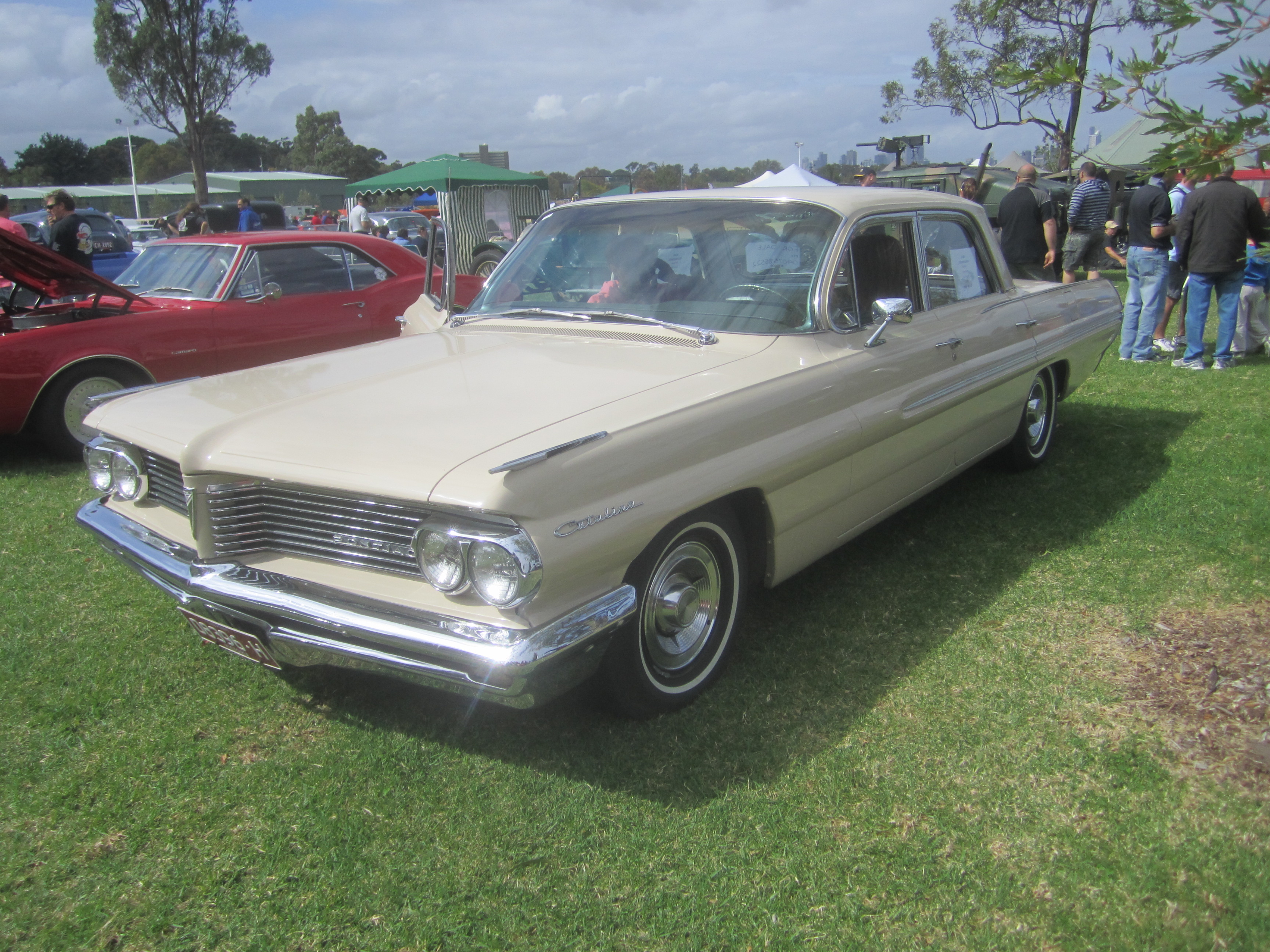
2. **1962 Pontiac Catalina 421 Super Duty**Pontiac, having successfully shed its somewhat staid image of the late 1950s, burst into the new decade with a renewed and vigorous interest in high-performance vehicles. This transformation was largely instigated by forward-thinking figures within the company, most notably Chief Engineer John DeLorean, who envisioned a brand synonymous with excitement and speed. To unequivocally assert its dominance on the drag strips that were becoming a cultural phenomenon across America, Pontiac embarked on a bold strategy: equipping its otherwise relatively unassuming Catalina model with a factory hot-rod engine, the mighty 421 Super Duty.
The heart of this drag-strip warrior was its formidable 421 cubic inch (6.9L) V8 engine, officially rated at a staggering 405 horsepower. However, it was widely acknowledged within automotive circles, and often proven on the dyno, that this engine produced significantly more power in reality, making it a true beast under the hood. Pontiac also employed an aggressive lightweight strategy to further enhance the Catalina’s performance; this included the use of aluminum fenders and bumpers, coupled with thin-gauge steel body panels, all meticulously designed to minimize the overall curb weight and maximize its power-to-weight ratio for unparalleled acceleration.
Complementing its potent engine and lightweight construction, the 421 Super Duty Catalina was most frequently paired with a robust 4-speed manual transmission, providing direct and uncompromised control for the driver. In certain configurations, heavy-duty automatics, specifically tailored for the brutal demands of drag racing, were also utilized. This combination allowed the Super Duty to achieve blistering quarter-mile times, often dipping into the low 13s or even high 12s when expertly tuned and driven. Such performance figures firmly cemented its place among the elite automotive performers of its era, making it a force to be reckoned with on the track.
The 1962 Pontiac Catalina 421 Super Duty stands as a rare and deeply revered machine, primarily due to its specialized, limited production and its singular focus on racing. While the standard Catalina model might not have possessed the flamboyant visual flair of later Pontiacs, such as the iconic GTO, these Super Duty versions were crafted in extremely small quantities, almost exclusively for dedicated racers. Surviving examples are now highly prized by collectors as a tangible testament to Pontiac’s pioneering success in building formidable, factory-engineered drag strip warriors, showcasing an early and profound commitment to American performance.
Car Model Information: 1963 Pontiac Catalina Sport Coupe
Caption: 1970 Pontiac Catalina hardtop coupe
Name: Pontiac Catalina
Manufacturer: Pontiac (automobile)
Production: 1950–1981
Platform: GM B platform
Predecessor: Pontiac Chieftain
Successor: Pontiac Bonneville
Class: Full-size car
Layout: FR layout
Categories: 1960s cars, 1970s cars, 1980s cars, All articles needing additional references, All articles with unsourced statements
Summary: The Pontiac Catalina is a full-size automobile produced by Pontiac from 1950 to 1981. Initially, the name was a trim line on hardtop body styles, first appearing in the 1950 Chieftain Eight and DeLuxe Eight lines. In 1959, it became a separate model as the “entry-level” full-size Pontiac.
The Catalina was Pontiac’s most popular model, available in multiple body styles, and served as the donor platform for the popular Pontiac Grand Prix, Pontiac 2+2, Pontiac Ventura, and the Pontiac Safari station wagon.
When the second-generation Pontiac Tempest was introduced in 1964, lessons learned from the Catalina’s introduction of the Grand Prix led to the introduction of the Pontiac GTO, to include the 389 cu in (6.4 L) Pontiac V8.
Get more information about: Pontiac Catalina
Buying a high-performing used car >>>
Brand: Pontiac Model: Catalina
Price: $38,981 Mileage: 38,300 mi.
Read more about: Unleashing the Beasts: 10 Legendary Muscle Cars That Defined the Roaring ’60s Automotive Golden Era
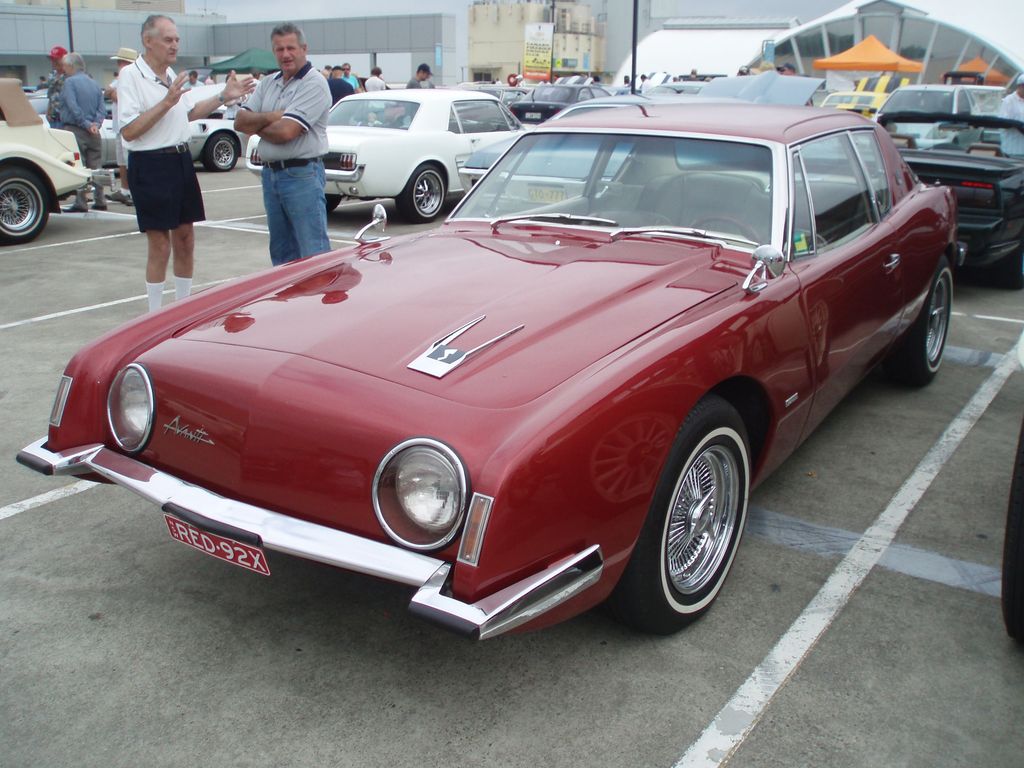
3. **1963 Studebaker Avanti R2**In the early 1960s, Studebaker found itself battling severe financial challenges, yet, in a bold and unexpected move, the company decided to embark on an ambitious project to completely revamp its corporate image. This initiative culminated in the creation of the Avanti, a strikingly sleek and futuristic automobile designed by the legendary Raymond Loewy. The Avanti’s primary goal was to seamlessly blend cutting-edge styling with genuine, exhilarating performance. To achieve an extra layer of visceral punch and underscore its performance credentials, the R2 specification was introduced, incorporating a Paxton supercharger to boost its output significantly.
The Avanti was truly ahead of its time in several respects, most notably in its body construction. It featured fiberglass body panels, a remarkable rarity in mainstream American cars of that period, which contributed to both its distinctive styling and lighter weight. Powering this futuristic machine was a 289 cubic inch (4.7L) V8 engine, which, thanks to the addition of the Paxton supercharger, was capable of producing approximately 289 horsepower. This innovative powertrain ensured that the Avanti could deliver on its promise of spirited performance, making it more than just a styling exercise.
Furthermore, the Avanti pushed the boundaries of automotive technology with its advanced brake system, featuring front disc brakes. This was an almost unheard-of innovation in U.S. production cars at the time, offering superior stopping power and control compared to the drum brakes prevalent on most contemporary vehicles. These technical advancements translated into impressive real-world performance; the Avanti R2 could accelerate from 0–60 mph in about 7 seconds and reach a top speed near 130–135 mph, showcasing its surprising pace and capability on the road.
The 1963 Studebaker Avanti R2 is celebrated today for its unique place in automotive history, despite its modest production numbers. Studebaker’s dwindling financial resources ultimately curtailed the Avanti’s production, and its radical, avant-garde appearance wasn’t universally appealing, leading to relatively few R2s rolling off the assembly line. For discerning enthusiasts and collectors, the Avanti R2 is cherished as a true gem, a “barn find treasure brimming with potential,” as the context aptly describes it. It perfectly encapsulates a distinctive blend of audacious design, advanced technology, and surprising performance, making it a compelling and rare piece of 1960s American automotive innovation.
Car Model Information: 1963 Studebaker Avanti
Name: Studebaker Avanti
Caption: 1963 Studebaker Avanti
Manufacturer: Studebaker
Aka: Avanti
Production: 1962: 1,200;
Assembly: Studebaker Corporation#Studebaker Factories,South Bend, Indiana
Predecessor: Studebaker Gran Turismo Hawk
Class: Personal luxury car
BodyStyle: coupe
Layout: FR layout
Engine: 289 CID
Abbr: on
Transmission: Manual transmission
Wheelbase: 109 in
Length: 192.4 in
Width: 70.3 in
Height: 53.8 in
Weight: 3095 lb
Related: Studebaker Lark
Designer: Raymond Loewy#Avanti
Categories: All articles with incomplete citations, Articles with incomplete citations from September 2018, Articles with short description, CS1 errors: missing title, Cars discontinued in 1963
Summary: The Studebaker Avanti is a personal luxury coupe manufactured and marketed by Studebaker Corporation between June 1962 and December 1963. A halo car for the maker, it was marketed as “America’s only four-passenger high-performance personal car.”
Described as “one of the more significant milestones of the postwar industry”, the Raymond Loewy-designed car offered safety features and high-speed performance. Called “the fastest production car in the world” upon its introduction, a modified Avanti reached over 170 mph (270 km/h) with its supercharged 289-cubic-inch (4,740 cm3) R3 engine at the Bonneville Salt Flats. In all, it broke 29 world speed records at the Bonneville Salt Flats.
Following Studebaker’s discontinuation of the model, a succession of five ventures manufactured and marketed derivatives of the Avanti model through 2006. These ventures licensed intellectual property and, in some cases procured parts, through arrangements with the successors to the Studebaker assets.
Get more information about: Studebaker Avanti
Buying a high-performing used car >>>
Brand: Studebaker Model: Avanti
Price: $38,863 Mileage: 19,130 mi.
Read more about: Beyond Their Era: 14 Classic Cars That Revolutionized Automotive Design and Engineering, Then Faded From Memory

4. **1964 Ford Thunderbolt (Fairlane)**The 1964 Ford Thunderbolt was not merely another car; it was a potent manifestation of Ford’s ambitious “Total Performance” campaign, a clear declaration of intent to dominate the motorsports world. This specialized vehicle took the relatively unassuming Fairlane body, known for its conservative styling, and dramatically transformed it by marrying it with a monstrous 427 big-block engine. The Thunderbolt’s design and engineering had a singular, unwavering purpose: to achieve absolute dominance in NHRA Super Stock drag racing, a mission it spectacularly accomplished. Ford even famously quipped that one could “opt for a passenger seat if you really wanted one,” a humorous but telling detail that underscored its single-minded, pure racing design.
At the core of the Thunderbolt’s ferocious performance was its legendary 427 cubic inch (7.0L) high-riser V8 engine. Officially rated at 425 horsepower, dynamometer tests frequently revealed that its true output often approached, or even exceeded, an astounding 500 horsepower, making it an incredibly powerful engine for its era. To further optimize its drag-racing prowess, Ford implemented extreme weight-saving measures. The car featured fiberglass doors, hood, and fenders, along with Plexiglas windows and a deliberately minimal interior, all meticulously designed to achieve the lightest possible curb weight and maximize its acceleration on the strip.
Power delivery in the Thunderbolt was managed through either a robust 4-speed manual transmission, often paired with a Hurst shifter for quick and precise gear changes, or a specially prepared drag-oriented automatic transmission, built to withstand the immense forces of hard launches. This meticulously engineered package allowed the Thunderbolt to achieve breathtaking quarter-mile times, consistently dipping into the mid-11s on slicks. Such unparalleled performance figures made it virtually unmatched in many respects during the 1964–65 drag racing seasons, establishing it as a true legend of the quarter-mile.
The 1964 Ford Thunderbolt holds an almost mythical status among collectors and racing enthusiasts, primarily due to its extremely limited production. Only around 100 units were ever built, solidifying its place as a rare, limited-production model that ushered in a new era of factory-sanctioned drag racing. For these reasons, finding an unaltered, original Thunderbolt today is an exceptionally difficult endeavor. Genuine examples of this automotive icon are now worth a considerable fortune, reflecting its profound historical significance and its enduring impact on American motorsports, making it a cherished piece of Ford’s “Total Performance” legacy.
Car Model Information: 1964 Ford Fairlane 500 Base
Name: Ford Fairlane Thunderbolt
Caption: Ford Fairlane Thunderbolt
Manufacturer: Ford Motor Company
ModelYears: 1964
Class: Muscle car
Assembly: Dearborn, MI
BodyStyle: sedan (automobile)
Layout: FR layout
Related: Mercury Cyclone
Wheelbase: 115.5 in
Abbr: on
Length: 197.5 in
Width: 72.5 in
Transmission: Cruise-O-Matic#MX.2FFX,manual transmission
Engine: {{convert,427,cuin,L,1,abbr=on,Ford FE engine#427
Weight: 3203 lb
Categories: All articles covered by WikiProject Wikify, All articles with bare URLs for citations, Articles covered by WikiProject Wikify from September 2022, Articles needing cleanup from September 2022, Articles with bare URLs for citations from September 2022
Summary: The Ford Fairlane Thunderbolt is a limited production, factory experimental, drag racing version of the Ford Fairlane produced during the 1964 model year only. A total of 100 units were produced; forty-nine 4-speeds and fifty-one automatics. A 4 speed secured the stick CLASS win at the US Nationals and secured the 1964 NHRA Super Stock championship for Ford.
Get more information about: Ford Fairlane Thunderbolt
Buying a high-performing used car >>>
Brand: Ford Model: Thunderbolt
Price: $43,500 Mileage: 83,618 mi.
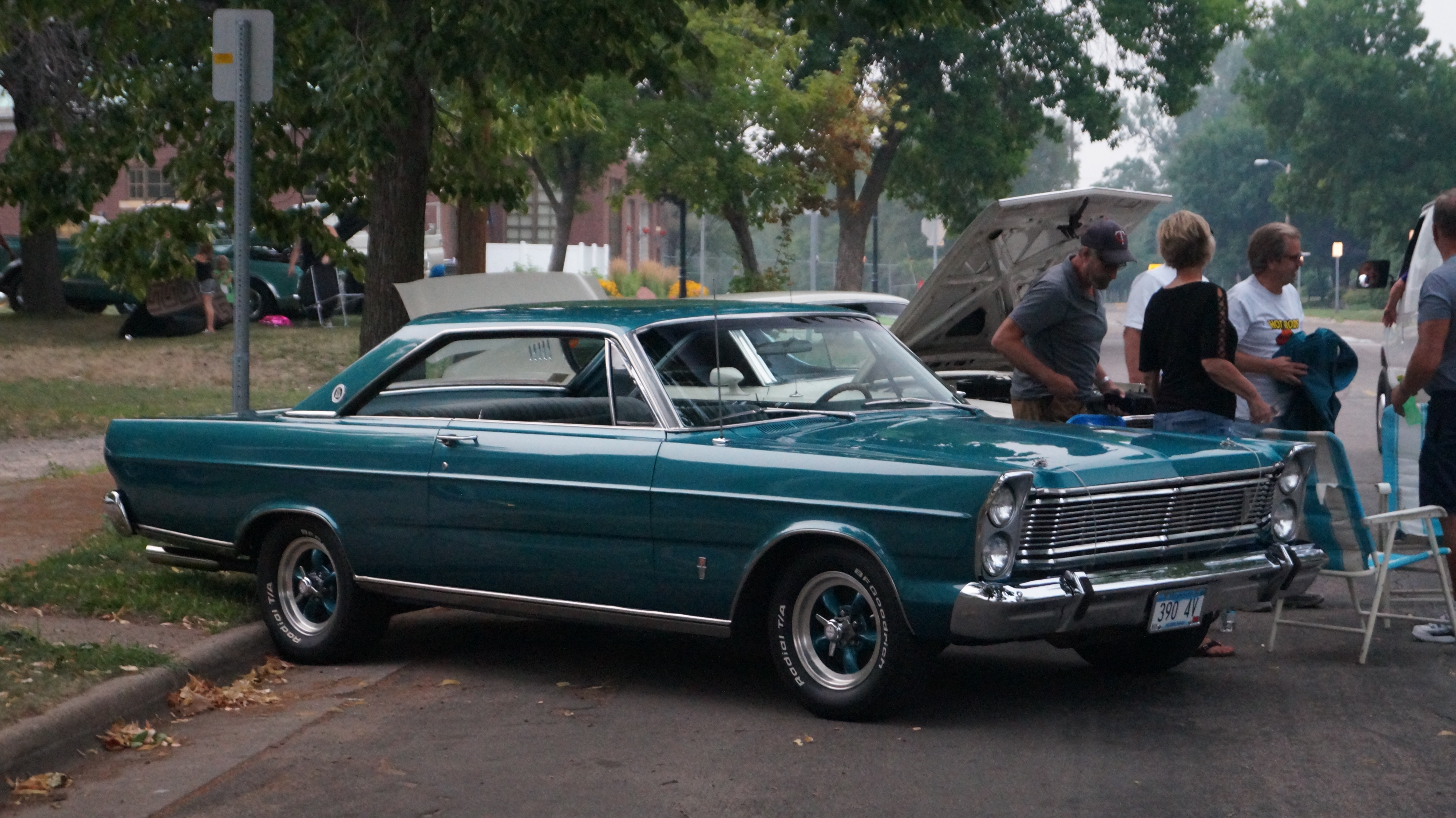
5. **1965 Ford Galaxie 500 Lightweight**While the ferocious Thunderbolt rightfully commanded headlines and dominated drag strips, Ford was simultaneously engaged in a broader performance optimization strategy, extending its efforts to its full-size Galaxie 500 model. This initiative aimed to enhance the Galaxie for both NASCAR and drag racing, showcasing Ford’s comprehensive commitment to motorsports across various platforms. Though it might have been overshadowed in the public eye by the more visually iconic Mustangs and Fairlanes of the era, the Galaxie 500 Lightweight stands out as a powerful testament to Ford’s pervasive “Total Performance” push throughout the mid-1960s, proving that even its larger vehicles could be transformed into formidable competitors.
Under the hood, the heart of the Galaxie 500 Lightweight was typically a robust 427 “side-oiler” big-block engine. This legendary power plant was specifically engineered to ensure reliable lubrication even at consistently high RPMs, a critical feature for sustained racing performance. In line with its “Lightweight” designation, Ford meticulously reduced the car’s overall mass through strategic modifications. This included the installation of aluminum bumpers and fiberglass hoods, which significantly cut down on weight compared to their standard steel counterparts. Furthermore, minimal sound-deadening materials were used, emphasizing its racing intent over passenger comfort, making every component a contribution to performance.
To effectively harness the immense power of the 427 engine, the Galaxie 500 Lightweight was equipped with either a highly robust 4-speed manual transmission or a heavy-duty automatic, both designed to withstand the rigors of competitive racing. Despite its larger dimensions and full-size platform, these comprehensive upgrades enabled the Lightweight to achieve impressive quarter-mile times. Depending on its specific setup and tuning, it could consistently run in the low 13s or even high 12s, demonstrating remarkable speed and capability for a vehicle of its stature, defying expectations for a full-size car.
The 1965 Ford Galaxie 500 Lightweight is a rare and revered machine, largely due to its modest production numbers. These specialized Galaxies were primarily produced for racing teams and a select handful of knowledgeable customers who understood how to navigate the intricate ordering process for such high-performance variants. Their somewhat overlooked status in the broader automotive narrative means that they are prime candidates for discovery as “barn find treasures.” Unearthing an intact original Galaxie 500 Lightweight is akin to a significant automotive archaeology find, offering a fascinating glimpse into Ford’s concerted effort to inject performance across its entire product line during a truly dynamic era.
Car Model Information: 2020 Audi Q5 45 Premium
Name: Ford Galaxie
Caption: 1963 Ford Galaxie 500 4-Door Sedan
Manufacturer: Ford Motor Company
Production: 1958–1974 (United States),1964–1968 (Australia),1967–1983 (Brazil)
ModelYears: 1959–1974
Assembly: Homebush West,Australia,São Paulo,Brazil
Class: Full-size
Layout: FR layout
Predecessor: Ford Fairlane (Americas)
Successor: Ford LTD (Americas)
Categories: 1960s cars, 1970s cars, All articles with unsourced statements, Articles with short description, Articles with unsourced statements from February 2010
Summary: The Ford Galaxie is a full-size automobile that was sold by the Ford Motor Company in North America from the 1959 to 1974 model years. Deriving its nameplate from a marketing tie-in with the excitement surrounding the Space Race, the Galaxie was offered as a sedan within the full-size Ford range throughout its production run. In the full-size segment, the model line competed against the Chevrolet Impala and Plymouth Fury.
The model line was assembled by Ford in multiple sites across the United States; four generations of the model line were produced. The Galaxie was also produced locally by Ford Australia and Ford Brasil, adopting commonality from the third-generation 1965 design.
Get more information about: Ford Galaxie
Buying a high-performing used car >>>
Brand: Ford Model: Galaxie 500
Price: $20,955 Mileage: 51,510 mi.
Read more about: 14 Legendary ’60s Muscle Cars That Defined an Era—and Still Steal the Show
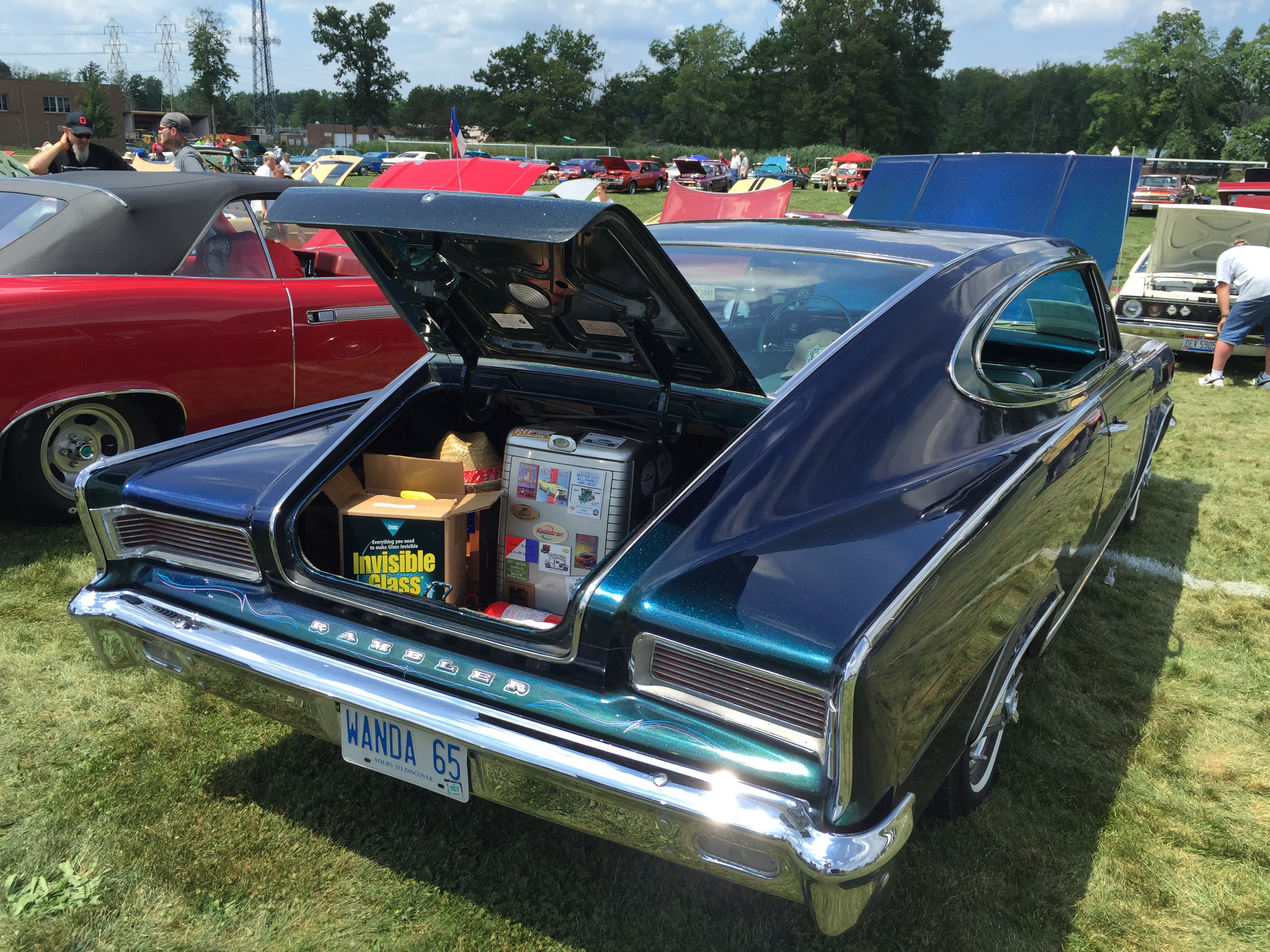
6. **1965 Rambler Marlin (AMC)**In the competitive landscape of the 1960s American automotive market, American Motors Corporation (AMC) found itself keen to shed its long-standing image as a purveyor of purely economical, sensible automobiles. With a desire to inject excitement and innovation into its lineup, AMC embarked on a creative endeavor to craft a stylish, performance-oriented car that would challenge the prevailing norms. The result was the Rambler Marlin, a distinctive vehicle characterized by its audacious, long fastback design, which boldly bucked the trend of the more conventional, boxy family sedans dominating the roads at the time, establishing a unique aesthetic presence.
The Marlin offered a versatile array of engine options, starting with a dependable 232 inline-six, catering to those who still valued efficiency. However, for drivers seeking a more spirited experience, a potent 327 cubic inch (5.4L) V8 engine was available, delivering approximately 270 horsepower. This optional V8 engine provided the Marlin with surprising vigor, allowing it to compete with more established performance cars in terms of raw power. The car’s most striking feature remained its unique fastback silhouette, which not only offered a streamlined and elegant look but also set it apart visually from almost everything else on the road.
To further enhance the Marlin’s appeal and performance characteristics, AMC offered a selection of transmissions, including traditional 3-speed and 4-speed manuals for those who preferred direct control over their driving experience. For convenience, AMC’s own Flash-O-Matic automatic transmission was also an option, providing smooth and reliable shifts. When equipped with the larger V8 engine and properly tuned, a Marlin could achieve a respectable 0–60 mph acceleration time of under 9 seconds. This performance figure was quite impressive for a mid-1960s intermediate car, demonstrating that the Marlin was more than just a styling statement.
The 1965 Rambler Marlin, despite its ambitious design and respectable performance, experienced modest sales during its initial run. This was largely due to AMC’s smaller dealership network compared to the Big Three, and the Marlin’s somewhat polarizing styling, which, while distinctive, wasn’t to everyone’s taste. Today, however, the Marlin has transformed into a cherished collector’s gem, particularly appealing to enthusiasts who seek something genuinely different from the ubiquitous Ford or GM offerings of the era. Especially when fitted with the more powerful V8 engine, the Marlin stands as a fascinating testament to AMC’s innovative spirit and its earnest attempt to carve out a unique niche in the competitive performance car market.
Car Model Information: 2020 Audi Q5 45 Premium
Name: Rambler Marlin,AMC Marlin
Caption: 1965 Rambler Marlin
Manufacturer: American Motors
Production: 1965–1967
Assembly: Kenosha, Wisconsin
Successor: AMC Rebel,AMC Ambassador,AMC Javelin
Class: Personal luxury car
BodyStyle: Fastback
Layout: FR layout
Platform: Rambler Classic,AMC Ambassador
Designer: Dick Teague
Categories: AMC vehicles, Articles with short description, CS1: unfit URL, CS1 errors: generic name, Cars introduced in 1965
Summary: The Rambler Marlin (later AMC Marlin) is a two-door fastback automobile produced in the United States by American Motors Corporation from 1965 to 1967. A halo car for the company, it was marketed as a personal luxury car.
In 1965, the car was marketed as “Rambler Marlin”. For 1966, the car featured “Marlin” identification only and was officially named “AMC Marlin”, as was the 1967 model.
Its fastback roof design was previewed on the 1964 Rambler Tarpon show car, based on the compact Rambler American. The 1965 and 1966 model year production Marlins were fastback versions of the mid-sized two-door hardtop Rambler Classic, and 1967 brought a major redesign in which the car was given the new, longer AMC Ambassador full-sized chassis. This version had a longer hood and numerous improvements, including more interior room and new V8 engines.
Get more information about: Rambler Marlin
Buying a high-performing used car >>>
Brand: AMC Model: Rambler Marlin
Price: $20,955 Mileage: 51,510 mi.
Read more about: Beyond the Chrome: A Deep Dive into 12 Iconic 1960s Luxury Car Ads That Defined a Golden Era of Automotive Storytelling

7. **1966 Dodge Charger 426 Hemi**The debut of the first-generation Dodge Charger in 1966 marked a significant entry into the burgeoning American performance car market. It immediately captivated onlookers with its sleek fastback design and a distinctive, full-length grille that gave it an undeniable presence. While this inaugural Charger model would later be somewhat overshadowed in broader pop culture by the more aggressively styled 1968–69 iterations, its initial offering, particularly when optioned with the legendary 426 Hemi engine, cemented its status as a serious contender. This powerful combination was Dodge’s overt pursuit of NASCAR success and outright street dominance, making these early Hemi Chargers exceptionally rare and highly coveted by Mopar aficionados.
The heart of this automotive powerhouse was the revered 426 cubic inch (7.0L) Hemi engine, officially rated at 425 horsepower. However, it was widely known and frequently demonstrated that its true output often tested significantly higher, unleashing an incredible surge of power that few contemporaries could match. Adding to its unique character, the first-generation Charger featured an interior quirk of four bucket seats, separated by a full-length center console, providing a sporty and distinct cabin experience. This design choice underscored its luxury-performance positioning, offering both comfort and a clear division for each occupant, an unusual feature for a car of its class.
To manage the monumental power of the Hemi engine, buyers could choose between the robust TorqueFlite 3-speed automatic transmission, known for its durability and smooth shifts, or a precise 4-speed manual. The manual option was particularly favored by those seeking a direct, uncompromised connection to the monstrous power plant. This potent combination allowed the 426 Hemi Charger to achieve sub-6-second 0–60 mph times and blaze through the quarter-mile in the mid-13s, an exceptionally quick performance for a large 1960s coupe. These figures placed it firmly at the pinnacle of American performance cars of its time, cementing its reputation as a drag strip terror and a street legend.
The 1966 Dodge Charger 426 Hemi remains an exceptionally rare and revered machine today, primarily because the Hemi engine option was notoriously expensive, severely limiting the number of customers who chose to “pony up” for it. Those who did, however, acquired a vehicle equipped with an engine that would later be universally recognized as one of the all-time greats in American performance automotive history. Its scarcity, combined with its profound impact on both racing and street culture, ensures that this first-generation Hemi Charger is a treasured possession for collectors, embodying the raw power and audacious spirit of the muscle car era.
Car Model Information: 2022 Dodge Charger SXT
Name: Dodge Charger
Caption: 1969 Dodge Charger
Manufacturer: Dodge
Production: 1966–1978,1981–1987,2005–present
ModelYears: 1966–1978,1982–1987,2006–present
Categories: 1960s cars, 1970s cars, 1980s cars, 2000s cars, 2010s cars
Summary: The Dodge Charger is a model of automobile marketed by Dodge in various forms over eight generations since 1966.
The first Charger was a show car in 1964. A 1965 Charger II concept car resembled the 1966 production version.
In the United States, the Charger nameplate has been used on mid-size cars, personal luxury coupes, subcompact hatchbacks, and full-size sedans.
Get more information about: Dodge Charger
Buying a high-performing used car >>>
Brand: Dodge Model: Charger
Price: $19,987 Mileage: 37,151 mi.
Read more about: 14 Legendary ’60s Muscle Cars That Defined an Era—and Still Steal the Show

8. **1966 Oldsmobile 442 W-30**Oldsmobile’s 442, a performance package introduced in 1964, truly soared with the W-30 option in 1966. This specialized offering elevated the 442 into muscle car legend. It incorporated factory Ram Air induction and meticulous tweaks, all designed to maximize performance and solidify its place among America’s elite vehicles. This was Oldsmobile’s sophisticated answer to the horsepower wars.
The heart of the 1966 W-30 was a specially prepared 400 cubic inch (6.6L) V8 engine. It featured an upgraded camshaft and distinctive red plastic inner fenders. These unique fenders funneled cooler outside air directly to the carburetor, improving combustion efficiency. This ingenious Ram Air system allowed the engine to breathe freely, unleashing its full potential.
Drivers chose a robust 4-speed manual for direct control or a 2-speed Jetaway automatic, later replaced by the 3-speed Turbo-Hydramatic. Regardless of transmission, the W-30 was a serious performer. It could achieve low 14-second quarter-mile times, with some tuned examples dipping into the thrilling 13-second range. It was a formidable contender on any drag strip.
The 1966 Oldsmobile 442 W-30 is revered due to its limited production compared to standard 442s. This exclusivity, combined with its unique blend of refined Oldsmobile comfort and explosive muscle, set it apart. For collectors, the W-30 is a highly desirable piece, representing a sophisticated, powerful statement from the era.
Car Model Information: 1969 Oldsmobile 442
Name: Oldsmobile 442
Manufacturer: Oldsmobile
ModelYears: 1964–1980,1985–1987,1990–1991
Class: Muscle car
Layout: FR layout
Caption: 1971 Oldsmobile 442
Categories: 1960s cars, 1970s cars, 1980s cars, All articles with unsourced statements, Articles with short description
Summary: The Oldsmobile 4-4-2 is a muscle car produced by Oldsmobile between the 1964 and 1987 model years. Introduced as an option package for US-sold F-85 and Cutlass models, it became a model in its own right from 1968 to 1971, spawned the Hurst/Olds in 1968, then reverted to an option through the mid-1970s. The name was revived in the 1980s on the rear-wheel drive Cutlass Supreme and early 1990s as an option package for the new front-wheel drive Cutlass Calais.
The “4-4-2” name (pronounced “Four-four-two”) derives from the original car’s four-barrel carburetor, four-speed manual transmission, and dual exhausts. It was originally written “4-4-2” (with badging showing hyphens between the numerals), and remained hyphenated throughout Oldsmobile’s use of the designation. Beginning in 1965, the 4-4-2s standard transmission was a three-speed manual along with an optional two-speed automatic and four-speed manual, but were still badged as “4-4-2″s.
Because of this change, from 1965 on, according to Oldsmobile brochures and advertisements, the 4-4-2 designation referred to the 400 cubic inch engine, four-barrel carburetor, and dual exhausts. By 1968, badging was shortened to simply “442”, but Oldsmobile brochures and internal documents continued to use the “4-4-2” model designation.
Get more information about: Oldsmobile 442
Buying a high-performing used car >>>
Brand: Oldsmobile Model: 442
Price: $43,990 Mileage: 24,000 mi.
Read more about: Unleashing the Roar: 14 Iconic Muscle Cars from the 1970s That Defined an Era of Power and Style for Enthusiasts
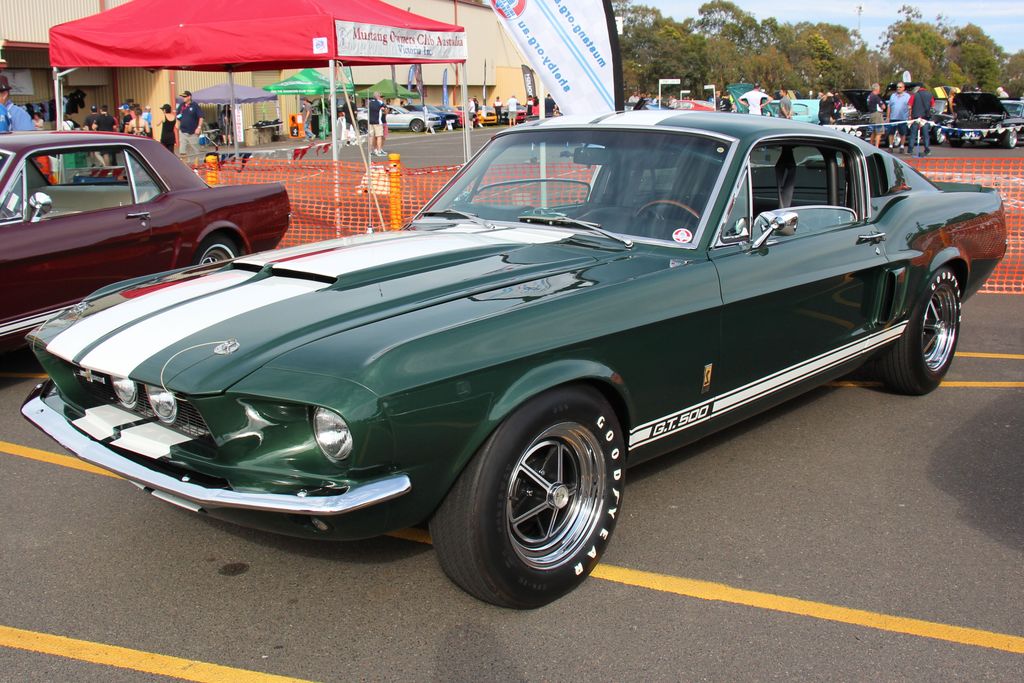
9. **1967 Shelby GT500**Carroll Shelby’s success with the agile GT350 paved the way for a new chapter in 1967: the GT500. This pivotal model introduced a massive big-block 428 V8 engine into the Mustang platform. It signaled Ford’s escalating commitment to raw horsepower, intensifying the muscle car wars. The GT500 redefined pony car performance, marking a bold shift for Shelby American.
At its core, the 1967 Shelby GT500 packed the legendary 428 cubic inch Police Interceptor V8. Officially rated at 355–360 horsepower, its true output was often significantly higher. This colossal powerplant provided a relentless surge of torque, transforming the Mustang into a thundering muscle machine. It was ready to challenge anything on the street or strip.
Shelby’s bespoke modifications gave the GT500 its aggressive character. A fiberglass hood with functional scoops enhanced its menacing appearance and aided cooling. Custom front fascia, upgraded suspension, and a reworked grille contributed to a visually assertive look. These enhancements transformed it into a specialized, performance-bred American icon.
A robust 4-speed manual transmission offered precise control. A capable 3-speed automatic was optional. This potent combination allowed the GT500 to sprint from 0–60 mph in approximately 5.7 seconds, with top speeds exceeding 120 mph. It was one of the quickest and most exhilarating cars of its era.
Unmolested 1967 Shelby GT500s remain incredibly valuable and highly coveted. They represent a definitive shift from small-block racing roots to big-block muscle mania in Shelby American’s timeline. Owning a ’67 GT500 means possessing a tangible piece of automotive history, encapsulating the audacious spirit and engineering prowess of the muscle car era.
Read more about: Beyond the Screen: Uncovering the Fates of the Most Iconic TV and Movie Cars Ever

10. **1967 Chevrolet Chevelle SS 396**The Chevrolet Chevelle SS 396 became one of GM’s most popular muscle cars, expertly bridging the gap between the compact Nova and full-size Impala. Chevrolet recognized the mid-size segment’s potential for performance vehicles. The Chevelle SS 396 offered a compelling blend of style, size, and power, resonating with buyers eager for exhilarating driving.
At its heart was the iconic 396 cubic inch (6.5L) V8 engine, available in multiple configurations. Customers chose from power levels rated at 325, 350, and a thrilling 375 horsepower. Each variant delivered a thunderous soundtrack and compelling acceleration, embodying pure American muscle. This flexibility allowed buyers to tailor their Chevelle’s ferocity.
To manage the 396 V8’s immense torque, Chevrolet offered rugged transmissions. The legendary 4-speed Muncie “Rock Crusher” manual was celebrated for its durability and crisp shifts. The robust Turbo-Hydramatic 400 automatic also offered smooth, reliable power delivery. Both made the Chevelle a formidable street machine.
Among the lineup, the ultra-rare L78 and L89 variants, with aluminum cylinder heads, pushed horsepower beyond 375. These transformed the Chevelle into an absolute beast on the strip. They were capable of tearing through the quarter-mile in the low- to mid-13-second range, cementing its reputation as a top-tier muscle car.
While many SS 396 Chevelles were sold, top-tier engine packages like the L89 are exceptionally rare. Collectors and restorers eagerly pay a significant premium for matching-numbers cars with these coveted performance codes. The 1967 Chevelle SS 396, especially its most potent forms, remains a celebrated icon of American muscle car history.
Car Model Information: 2020 Audi Q5 45 Premium
Name: Chevrolet Chevelle
Caption: 1970 Chevrolet Chevelle SS 396 Sport Coupe
Manufacturer: Chevrolet
Production: 1963–1977
ModelYears: 1964–1977
Class: Mid-size
Platform: GM A platform (RWD)
Layout: FR layout
Successor: Chevrolet Malibu
Categories: 1970s cars, All articles needing additional references, All articles that may contain original research, All articles with specifically marked weasel-worded phrases, All articles with unsourced statements
Summary: The Chevrolet Chevelle is a mid-sized automobile that was produced by the Chevrolet division of General Motors (GM) in three generations for the 1964 to 1977 model years. Part of the GM A-body platform, the Chevelle was one of Chevrolet’s most successful nameplates. Body styles included coupes, sedans, convertibles, and station wagons. The “Super Sport” versions were produced through the 1973 model year and Lagunas from 1973 through to 1976.
After a four-year absence, the El Camino was reintroduced as part of the new Chevelle lineup in 1964.
From 1964 to 1969, GM of Canada sold a modified version of the Chevelle that included a Pontiac-style grille, and a LeMans instrument panel, marketed as the Beaumont.
The Malibu was the top-of-the-line model to 1972, and completely replaced the Chevelle nameplate starting with the redesigned, and downsized 1978 model year.
Get more information about: Chevrolet Chevelle
Buying a high-performing used car >>>
Brand: Chevrolet Model: Chevelle SS 396
Price: $20,955 Mileage: 51,510 mi.
Read more about: Behind Closed Doors: Unveiling Dwayne ‘The Rock’ Johnson’s Multi-Million Dollar Muscle & Supercar Collection

11. **1967 Mercury Cougar XR-7**In 1967, Mercury launched the Cougar as a sophisticated, upscale alternative to the Mustang. It emphasized comfort and refined style while delivering respectable performance. The XR-7 trim further solidified this luxury-sport positioning, bringing premium elements and a distinctive character.
The Cougar XR-7’s interior showcased its “luxury sport” aspirations. It boasted full instrumentation, rich leather seating, and tasteful wood-grain dashboard accents. Aircraft-style toggle switches created a refined, cockpit-like ambiance. This meticulously crafted cabin elevated the driving experience.
Under the hood, the Cougar XR-7 offered robust engine options. Base models had a 289 V8, but enthusiasts could opt for a 390 or 428 V8. Equipped with the potent 390 V8, it achieved mid-14-second quarter-mile times. This proved the Cougar was a legitimate performer, offering spirited driving.
One of the most captivating styling cues was its distinctive sequential turn signals and concealed headlights. These hidden headlights provided a clean, uncluttered front fascia when off. This innovative design, combined with its muscular lines, gave the Cougar an undeniable presence, hinting at both performance and inherent class.
XR-7 Cougars, especially with big-block engines, remain highly sought-after collector’s items. Their unique blend of sophisticated style, respectable performance, and relative scarcity ensures their iconic status. For Ford fans wanting a refined Mustang alternative, the 1967 Mercury Cougar XR-7 is a testament to luxury-sport success.
Car Model Information: 1995 Mercury Cougar XR7
Name: Mercury Cougar
Caption: 1969 Mercury Cougar (first generation)
Manufacturer: Mercury (automobile)
Layout: Front-engine, rear-wheel-drive layout
ModelYears: 1967–1997,1999–2002
Class: Pony car,Personal luxury car,Mid-size car,Sport compact
Categories: 1960s cars, 1970s cars, 1980s cars, 1990s cars, 2000s cars
Summary: The Mercury Cougar is a series of automobiles that was sold by Mercury from 1967 to 2002. The model line is a diverse series of vehicles; though the Cougar nameplate is most commonly associated with two-door coupes, at various stages in its production, the model also was offered as a convertible and a hatchback. During its production as the mid-size Mercury line, the Cougar was also offered as a four-door sedan and five-door station wagon.
In production for 34 years across eight generations (skipping the 1998 model year), the Cougar is second only to the Grand Marquis (36 years) in the Mercury line for production longevity. 2,972,784 examples were produced, making it the highest-selling Mercury vehicle. During the 1970s and 1980s, the marketing of the Mercury division was closely associated with the Cougar, with promotional materials advertising Mercury dealers as “The Sign of the Cat” with big cats atop Lincoln-Mercury dealer signs. Cat-related nameplates were adopted by other Mercury lines, including the Bobcat and Lynx.
During its production, the Cougar was assembled at the Dearborn Assembly Plant (part of the Ford River Rouge Complex) in Dearborn, Michigan from 1967 until 1973, San Jose Assembly (Milpitas, California) from 1968 into early 1969, Lorain Assembly (Lorain, Ohio) from 1974 until 1997, and at Flat Rock Assembly (Flat Rock, Michigan) from 1999 through 2002.
Get more information about: Mercury Cougar
Buying a high-performing used car >>>
Brand: Mercury Model: Cougar
Price: $10,995 Mileage: 37,589 mi.
Read more about: 14 Legendary ’60s Muscle Cars That Defined an Era—and Still Steal the Show

12. **1968 Ford Mustang 428 Cobra Jet (Non-Shelby)**In mid-1968, Ford introduced the 428 Cobra Jet Mustang, offering enthusiasts a potent, yet affordable, alternative to Shelby variants. This factory-backed weapon was a mix of high-performance components. It delivered track-ready power directly from the factory, bypassing Shelby’s premium, quickly gaining legendary status.
The star was the magnificent 428 cubic inch (7.0L) Cobra Jet V8. Ford notoriously underrated its output at 335 horsepower, but real-world tests often showed it topped 400 hp. This discrepancy added to its mystique, providing far more raw power than expected. It was a torque monster, delivering exhilarating, seat-pinning acceleration.
Its functional Ram Air induction system enhanced performance. A distinctive hood scoop funneled cooler, denser outside air directly into the carburetor. This was crucial for maximizing horsepower and improving combustion efficiency under hard acceleration. This ingenious design ensured peak power when it mattered most.
Buyers chose between the durable 4-speed Toploader manual or a robust C6 automatic transmission. This powerful combination propelled the Cobra Jet through the quarter-mile in the high 13-second range in factory trim. Experienced drivers and minor upgrades pushed it even quicker, an impressive feat for a production car.
The 1968 Ford Mustang 428 Cobra Jet holds a special place due to its mid-year introduction and limited production. For many, it offered the ultimate “bang for the buck” in Ford’s muscle lineup. This blend of raw power, factory engineering, and scarcity makes it a prime target for racers and dedicated collectors of American classics.
Car Model Information: 2024 Ford Mustang Mach-E GT
Name: Ford Mustang
Caption: 2024 Ford Mustang GT Convertible
Aka: Ford T5 (Germany)
Manufacturer: Ford Motor Company
Production: March 1964 – present
ModelYears: 1965–present
Class: Unbulleted list
BodyStyle: Unbulleted list
Layout: Front-engine, rear-wheel-drive layout
Categories: 1970s cars, 1980s cars, 1990s cars, 2+2 coupés, 2000s cars
Summary: The Ford Mustang is an American automobile manufactured and marketed by Ford since 1964, as Ford’s longest nameplate in continuous production. Currently in its seventh generation, it is the fifth-best selling Ford car nameplate. The namesake of the “pony car” automobile segment, the Mustang was developed as a highly styled line of sporty coupes and convertibles derived from existing model lines, initially distinguished by its pronounced “long hood, short deck” proportions.
Originally predicted to sell 100,000 vehicles yearly, the 1965 Mustang became the most successful vehicle launch since the 1927 Model A. Introduced on April 17, 1964 (16 days after the Plymouth Barracuda), over 400,000 units were sold in its first year; the one-millionth Mustang was sold within two years of its launch. In August 2018, Ford produced the 10-millionth Mustang; matching the first 1965 Mustang, the vehicle was a 2019 Wimbledon White convertible with a V8 engine.
The success of the Mustang launch led to multiple competitors from other American manufacturers, including the Chevrolet Camaro and Pontiac Firebird (1967), AMC Javelin (1968), and Dodge Challenger (1970). It also competed with the Plymouth Barracuda, which was launched around the same time. The Mustang also had an effect on designs of coupes worldwide, leading to the marketing of the Toyota Celica and Ford Capri in the United States (the latter, by Lincoln-Mercury). The Mercury Cougar was launched in 1967 as a unique-bodied higher-trim alternative to the Mustang; during the 1970s, it included more features and was marketed as a personal luxury car.
From 1965 until 2004, the Mustang shared chassis commonality with other Ford model lines, staying rear-wheel-drive throughout its production. From 1965 to 1973, the Mustang was derived from the 1960 Ford Falcon compact. From 1974 until 1978, the Mustang (denoted Mustang II) was a longer-wheelbase version of the Ford Pinto. From 1979 until 2004, the Mustang shared its Fox platform chassis with 14 other Ford vehicles (becoming the final one to use the Fox architecture). Since 2005, Ford has produced two generations of the Mustang, each using a distinct platform unique to the model line.
Through its production, multiple nameplates have been associated with the Ford Mustang series, including GT, Mach 1, Boss 302/429, Cobra (separate from Shelby Cobra), and Bullitt, along with “5.0” fender badging (denoting 4.9 L OHV or 5.0 L DOHC V8 engines).
Get more information about: Ford Mustang
Buying a high-performing used car >>>
Brand: Ford Model: Mustang
Price: $38,959 Mileage: 12,668 mi.

13. **1968 Mercury Comet Cyclone Spoiler II**The late 1960s witnessed intense aerodynamic warfare on NASCAR tracks. The 1968 Mercury Comet Cyclone Spoiler II emerged from this fierce environment as a pure homologation special. Meticulously crafted to meet NASCAR rules, it directly challenged rival aerodynamic tactics, showcasing Mercury’s commitment to track dominance.
The Cyclone Spoiler II’s most striking feature was its aggressively extended and reshaped nose cone. This radical modification, unique to the model, dramatically reduced aerodynamic drag at superspeedway speeds. A flush-mounted grille further streamlined the front profile. Every contour was designed for maximum efficiency, a testament to the era’s cutting-edge racing engineering.
Under this aerodynamically optimized shell, the Spoiler II typically featured Ford’s formidable 427 or 428 Cobra Jet V8 engines. These potent powerplants ensured the Spoiler II had the raw horsepower to match its slippery exterior. Some units received the capable 390 V8, but big-block variants truly embodied its racing intent.
The 1968 Mercury Comet Cyclone Spoiler II is an automotive unicorn due to its incredibly limited production, with only 351 units built. This extreme scarcity makes it one of the most desirable machines from the muscle car era. As a pure homologation special, it represents a fascinating chapter in NASCAR’s aerodynamic wars and is highly sought by collectors.
Car Model Information: 2020 Audi Q5 45 Premium
Name: Mercury (Comet) Cyclone
Caption: 1971 Mercury Cyclone GT
Manufacturer: Mercury (automobile)
ModelYears: 1964–1971
Class: Muscle car
Layout: FR layout
Predecessor: Mercury Comet
Successor: Mercury Cougar#Third generation (1974–1976)
Related: Mercury Comet,Ford Fairlane (Americas),Mercury Montego,Ford Torino Talladega
BodyStyle: coupe
Categories: 1970s cars, Articles with short description, Cars introduced in 1964, Commons category link from Wikidata, Coupés
Summary: The Mercury Cyclone is an automobile that was marketed by the Mercury division of Ford from 1964 to 1971. Introduced in 1964 as the Mercury Comet Cyclone, the Cyclone replaced the S-22 as the performance-oriented version of the Mercury Comet model line. The Cyclone became a distinct nameplate for the 1968 model year, as the Mercury Montego was phased in to replace the Comet.
Within Mercury, the Cyclone was positioned between the Cougar pony car and the Marquis/Marauder full-size two-doors. Though largely overshadowed by the Cougar, the Cyclone was positioned as a muscle car, representing the Mercury brand in racing as a clone of the Ford Fairlane Thunderbolt.
Four generations of the Cyclone were produced, with production ending after the 1971 model year. For the 1972 model year, the Cyclone returned as an option package for the Montego; only 30 examples were produced. Within the Mercury line, the Cyclone was not directly replaced. The Cougar XR7 was repackaged as a personal luxury version of the Montego for 1974.
Get more information about: Mercury Cyclone
Buying a high-performing used car >>>
Brand: Mercury Model: Comet Cyclone Spoiler II
Price: $20,955 Mileage: 51,510 mi.
Read more about: Unearthing Hidden Gems: 14 Overlooked Muscle Cars That Offer Serious Performance Without Breaking the Bank for Savvy Collectors
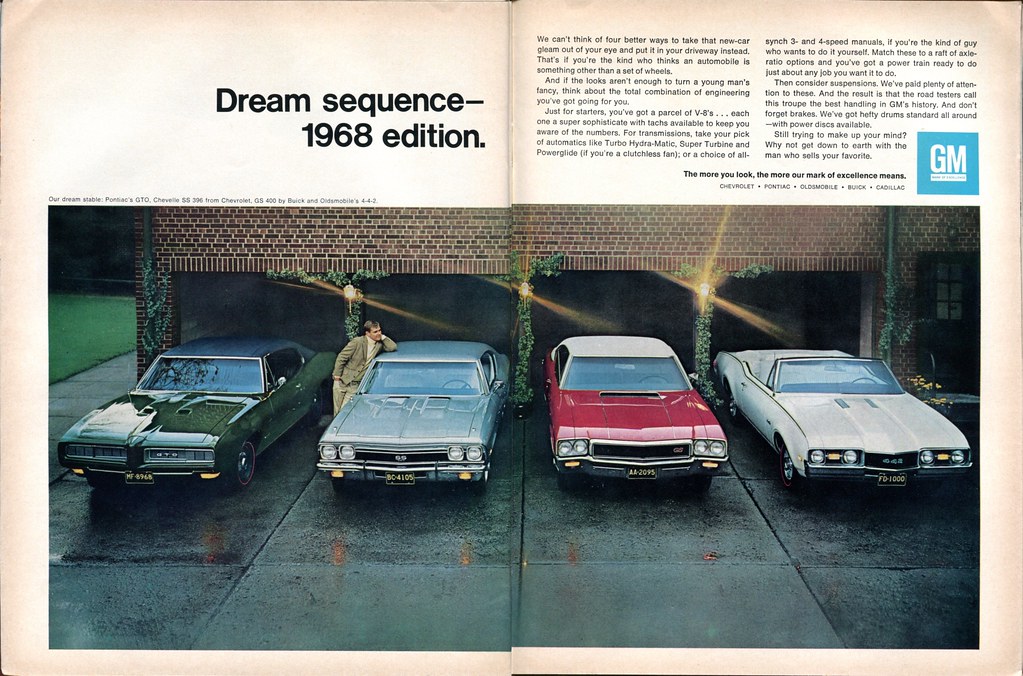
14. **1968 Buick GS 400**Buick’s Grand Sport (GS) line offered a distinct and compelling entry into the 1960s muscle car market. The GS provided a unique Buick interpretation of performance: a sophisticated blend of big-block power with a refined, luxurious driving experience. The 1968 GS 400 evolved this formula, delivering formidable performance without sacrificing Buick’s signature comfort.
Powering the 1968 Buick GS 400 was its robust 400 cubic inch (6.6L) V8 engine, rated at 340 horsepower. This engine was renowned for its incredibly strong low-end torque, providing a smooth yet authoritative surge of acceleration. It delivered power with Buick’s characteristic refinement, making its formidable output accessible and manageable.
Styling-wise, the GS 400 proudly displayed its performance intentions with distinctive hood scoops and prominent GS badging. Inside, the cabin exuded Buick’s upscale ambiance, featuring plush seating and well-appointed amenities. This comfortable interior was a thoughtful counterpoint to the raw power beneath the hood.
This unique combination of muscle and luxury allowed the 1968 GS 400 to carve its own niche. It was a formidable performer, capable of mid-14-second quarter-mile times. Crucially, it offered this speed and exhilaration wrapped in a package that prioritized comfort and a refined ride.
The 1968 Buick GS 400 maintains a special appeal today due to its relative scarcity, especially with rare options. It stands as a testament to Buick’s unique approach to the muscle car era, offering a distinct blend of power and luxury. For discerning collectors, the GS 400 is cherished as a sophisticated alternative.
Car Model Information: 2020 Audi Q5 45 Premium
Name: Gran Sport
Logo: Buick gs emblem.png
Producttype: Performance car
Currentowner: General Motors
Producedby: General Motors
Introduced: [object Object]
Related: T-Type
Markets: U.S.
Categories: All Wikipedia articles in need of updating, All articles with unsourced statements, Articles with short description, Articles with unsourced statements from September 2020, Articles with unsourced statements from September 2025
Summary: The Gran Sport name has been used on several high-performance cars built by General Motors for its Buick brand since 1965. In the GM brands hierarchy, Buick was surpassed in luxury and comfort appointments only by Cadillac, which did not produce performance models. As a result, the Buick GS series were the most opulently equipped GM sport models of their era.
The Gran Sport performance enhancements on all Buick products during this era sought to affirm Buick’s tradition of producing powerful and comfortable products going back to the 1930s when all Buicks of the time were upgraded to the Buick Fireball Straight Eight, then installed the 278 cu in (4.6 L) Roadmaster engine in the shortest model Special and introduced the Century, known as “the banker’s hot rod” with a three speed synchromesh manual transmission. The Gran Sport sought to identify cars that were fun to drive with a luxury approach.
Get more information about: Buick Gran Sport
Buying a high-performing used car >>>
Brand: Buick Model: GS 400
Price: $20,955 Mileage: 51,510 mi.
Read more about: 14 Classic Rides That Boomers Loved But Millennials and Gen Z Just Can’t Stand: Unpacking Why These Iconic Cars Fail to Appeal Now
**The enduring appeal of these legendary machines from the latter half of the 1960s is a powerful reminder of an era when American automotive ingenuity truly soared.** From Oldsmobile’s sophisticated muscle to Shelby’s big-block masterpieces, and from Mercury’s aerodynamic marvels to Buick’s luxurious performance, each vehicle contributed a unique chapter to a decade of unparalleled innovation. These cars weren’t just modes of transportation; they were bold statements, technological showcases, and cultural touchstones that collectively cemented the 1960s as America’s greatest car decade. Their distinct designs, groundbreaking engineering, and relentless pursuit of power continue to captivate generations, ensuring their legacy as timeless icons cherished by enthusiasts worldwide.



